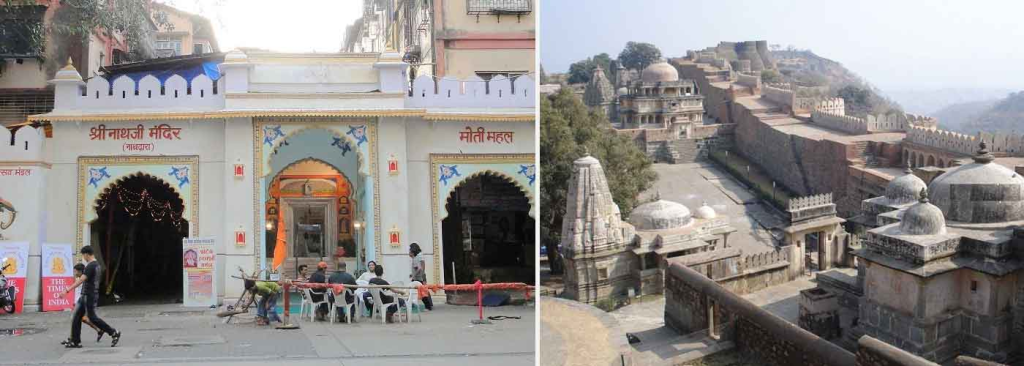
3 Days in Udaipur: The Ultimate Travel Itinerary and Guide
July 18, 2025
Discovering Ahar Cenotaphs: Udaipur’s Historic Royal Cremation Ground
July 30, 2025The serene embrace of Udaipur’s lakes and palaces is complemented by a spiritual heart that beats in rhythm with centuries of devotion. At the center of this spiritual tapestry stands shreenathji udaipur, the beloved form of Lord Krishna worshipped with unwavering faith. Nestled against the backdrop of the City of Lakes, shrinathji temple udaipur is more than a monument; it is a living, breathing embodiment of devotion, art, music, and culture. Whether you’re a pilgrim or a tourist, the experience of visiting shrinathji mandir udaipur is often enhanced by staying in a comfortable Hotel in Udaipur, many of which are located near the temple, offering easy access for early morning rituals. This article explores every facet of shrinathji mandir udaipur, from its legendary origins to its daily rituals, including the sacred shrinathji darshan time and the early morning shrinathji mangla darshan, reflecting on why pilgrims and tourists alike feel drawn to this divine abode.

Historical Origins of Shrinathji in Udaipur
The divine form of Shrinathji, worshipped at the sacred shreenathji udaipur, represents Lord Krishna as a seven-year-old child—an incarnation known lovingly as Gopala. This specific Swaroop of Krishna, deeply venerated in the Pushtimarg tradition, was first worshipped by the revered saint Vallabhacharya in the holy Govardhan region of Vrindavan. Today, this very divine presence continues to bless devotees at shrinathji temple udaipur, a revered destination for those seeking spiritual connection in the City of Lakes.
The idol housed in shrinathji mandir udaipur is a marvel in itself. Crafted from a single piece of black stone, this monolithic sculpture of Lord Shrinathji stands as a symbol of spiritual strength and divine will. According to ancient legends, the stone from which the idol of Shrinathji is carved is believed to have self-manifested from the sacred Govardhan Mountain around the 12th century BC. It was this same mountain that Lord Krishna famously lifted on his little finger to protect the people of Vrindavan from the torrential rains unleashed by a wrathful Indra. This divine act is immortalized in the idol now venerated in shreenathji udaipur, and it is this same divine essence that devotees experience during their sacred shrinathji darshan time.
Architectural Splendor and Artistic Grandeur
Entering the precincts of shrinathji temple udaipur is to step into an architectural marvel. The fusion of Rajasthani and Gujarati styles is evident in the intricately carved pillars, floral motifs, and frescoes that adorn the walls. Each corner of shreenathji udaipur whispers tales of artisans who labored lovingly over stone and paint, capturing every nuance of Krishna’s divine leelas. The sanctum sanctorum, where the idol resides, is framed by polished marble and gilded arches, reflecting the first light of day during shrinathji darshan time. The ceilings resonate with the echoes of kirtans, and the corridors display paintings depicting Krishna’s childhood, reinforcing why shrinathji mandir udaipur remains a pilgrimage destination for art and faith alike.
The Idol: Shrinathji’s Divine Form
At the heart of shreenathji udaipur lies the seven-year-old form of Lord Krishna, manifested as Shrinathji. Carved from a single black marble stone, the idol’s posture—lifting the Govardhan hill—symbolizes divine protection. The idol is adorned daily in exquisite garments and jewelry, each chosen to reflect the season and devotional mood. During shrinathji mangla darshan, the first glimpse of the beautifully dressed idol at dawn fills devotees’ hearts with joy. The tender features of Shrinathji’s face, the gentle curve of his peacock-feathered crown, and the graceful lift of his arm all invite deep contemplation, making shrinathji temple udaipur a uniquely intimate venue for spiritual connection.
Daily Rituals and Timings
Central to the rhythm of life at shreenathji udaipur are the daily rituals that punctuate the temple’s schedule. The earliest is shrinathji mangla darshan, beginning before sunrise, where devotees gather to witness the first invocation of the Lord. Following this is the bhog offerings, the midday aarti, and finally the sandhya aarti. The precise shrinathji darshan time for each ritual is published monthly, allowing pilgrims to plan their visit. While many temples simply announce general hours, shrinathji temple udaipur provides detailed schedules for mangla darshan, shringar (dressing), rajbhog (midday meal), and shayan (night rest), fostering a deeper participatory experience.
Festivals and Celebrations
Throughout the year, shrinathji mandir udaipur comes alive with festivals that celebrate Krishna’s life and glory. Janmashtami, commemorating Krishna’s birth, transforms the temple into a vibrant arena of devotional singing and enactments of divine plays. During Holi—known here as Phag Utsav—the temple courtyard bursts with color and song, reenacting Krishna’s playful spirit. Govardhan Puja highlights the story behind the idol’s posture, drawing thousands of devotees for special shrinathji darshan time dedicated to this legend. Every festival amplifies the communal spirit, reinforcing why shreenathji udaipur stands as a beacon of living tradition.

Music, Dance, and Cultural Expressions
Artistic expression is woven into the fabric of shreenathji temple udaipur. Traditional kirtans and bhajans, performed in languages from Sanskrit to Braj Bhasha, uplift the congregation. Kathak dancers interpret Krishna’s lilas through rhythmic footwork, while puppetry shows depict scenes from the Bhagavata Purana. Even those who come simply to observe cannot help but be drawn into participation, as the music and dance invite inner devotion. This cultural vibrancy distinguishes shrinathji mandir udaipur from other pilgrimage sites, making each visit an immersive experience of the arts.
Pilgrim Experiences and Testimonials
Countless devotees recount transformative experiences at shrinathji temple udaipur. For some, witnessing the first rays of dawn illuminating the deity during shrinathji mangla darshan brings profound peace. Others describe feeling the weight of their burdens lifted after offering prayers at the site. Pilgrims often share stories of answered prayers—be it healing illness or restoring peace in troubled homes—cementing the temple’s reputation as a powerful place of grace. These testimonials, shared in travel journals and social media, inspire others to journey to shreenathji udaipur, reinforcing the cycle of devotion and faith.
Accommodation and Pilgrim Facilities
While shrinathji temple udaipur itself does not provide commercial lodging, its location in the historic city center places pilgrims within easy reach of traditional guesthouses and dharamshalas. Many of these establishments cater specifically to devotees, offering simple accommodations and communal meals. Though prices vary, none are mentioned here, allowing visitors to explore options suited to their preferences. Temple volunteers and local guides often assist newcomers in finding suitable lodgings, ensuring that shrinathji darshan time is accessible to all who seek it.
How to Reach the Temple
Shrinathji temple udaipur is centrally located, making it accessible by road, rail, and air. From Udaipur City Railway Station, visitors can hire a rickshaw or taxi to reach the temple precinct. Those arriving by flight at Maharana Pratap Airport find city transport options plentiful. The temple’s proximity to major landmarks like Lake Pichola and City Palace means that pilgrims can combine spiritual visits with sightseeing. Signage throughout the old city directs travelers to shreenathji mandir udaipur, ensuring that even first-time visitors can locate the shrine with ease.
Tips for First-Time Visitors
For those planning their first visit to shreenathji temple udaipur, a few guidelines can enhance the experience. Arrive early to participate in shrinathji mangla darshan and secure a place near the sanctum. Dress modestly and remove footwear before entering the inner precincts. Photography rules vary by event, so it’s advisable to inquire with temple staff. Donating items like flowers or sweets at the appropriate shrinathji darshan time supports temple activities. Finally, take time to explore the surrounding bazaars, where local artisans sell devotional paraphernalia, allowing pilgrims to bring home a tangible memory of shreenathji udaipur.

Conclusion: A Spiritual Oasis in the City of Lakes
The story of shreenathji udaipur is one of enduring faith, artistic brilliance, and communal harmony. Shrinathji temple udaipur stands as a testament to the power of devotion, uniting people across generations in the worship of the divine child Krishna. From the gentle glow of dawn during shrinathji mangla darshan to the evening aarti’s haunting melodies, every moment in this sacred space invites reflection and joy. Whether you are a seasoned pilgrim or a curious traveler on an Udaipur sightseeing tour, the doors of shrinathji mandir udaipur welcome you to partake in a living tradition that continues to inspire hearts and souls.
FAQS
What is the significance of Shrinathji’s idol in Shreenathji Udaipur?
The idol of Shrinathji at shreenathji udaipur represents Lord Krishna as a seven-year-old child lifting the Govardhan Mountain. This form, known as Gopala, is worshipped for divine protection, love, and grace. The idol is carved from a single black stone and believed to be self-manifested from the Govardhan Hill, giving shrinathji temple udaipur a sacred and miraculous history.
Who first started the worship of Shrinathji and where?
The worship of Shrinathji began in the Govardhan region of Vrindavan by the great saint Vallabhacharya. This form of Krishna was later brought to Nathdwara and holds spiritual importance even in shreenathji udaipur where the tradition continues with great devotion at shrinathji mandir udaipur.
Why was the idol of Shrinathji moved, and how did it reach Udaipur?
During the Mughal invasion, especially under Emperor Aurangzeb, the idol was moved from Vrindavan to protect it from destruction. While being transported, the chariot carrying the idol stopped suddenly, which was seen as the Lord’s wish to stay at that place. This miraculous event eventually led to the temple’s foundation, influencing the spiritual tradition seen today in shreenathji temple udaipur and shrinathji mandir udaipur.
What makes the architecture and rituals of Shrinathji Temple Udaipur unique?
Shrinathji temple udaipur combines Rajasthani and devotional art with deep-rooted spiritual traditions. The idol is dressed differently throughout the day, and rituals are carefully performed during designated shrinathji darshan time. The temple is known for its detailed daily routine, especially the peaceful shrinathji mangla darshan, which takes place early in the morning.
What is Shrinathji Mangla Darshan, and why is it important?
Shrinathji mangla darshan is the first darshan of the day at shreenathji udaipur, typically held at dawn. It is considered highly auspicious, as devotees believe witnessing the Lord’s first glimpse in the morning brings blessings and spiritual awakening. This time is often filled with devotional music and calm prayers, marking a beautiful start to the day at shrinathji mandir udaipur.
How is Shrinathji Darshan Time scheduled at the temple?
The shrinathji darshan time is divided into multiple sessions throughout the day, including mangla, shringar, rajbhog, utthapan, and shayan. Each session represents a different mood and appearance of Lord Shrinathji. The temple provides a detailed schedule so that devotees visiting shreenathji udaipur can participate in darshans according to tradition and personal devotion.




